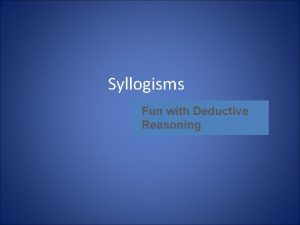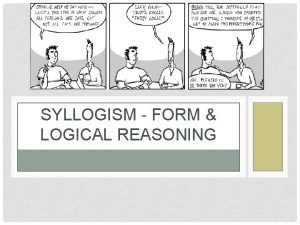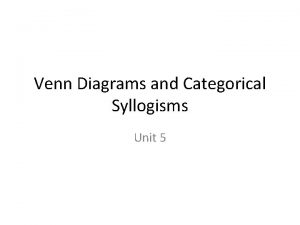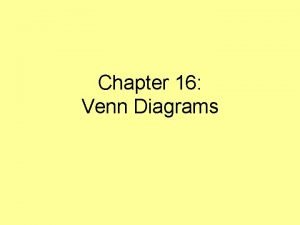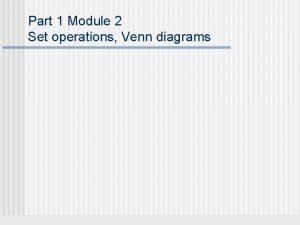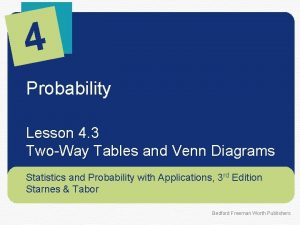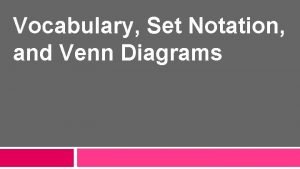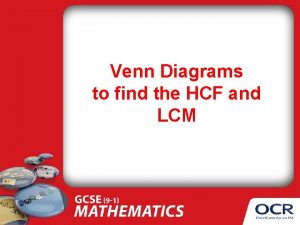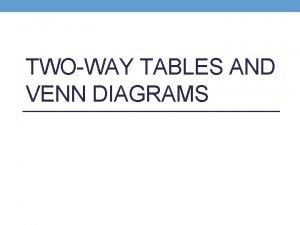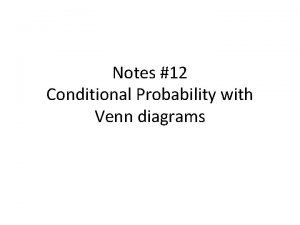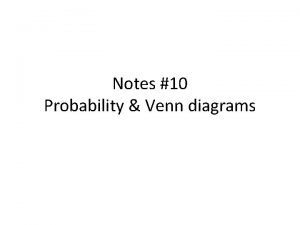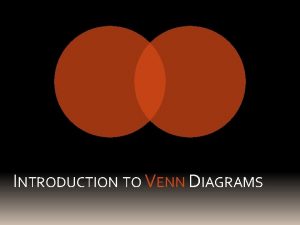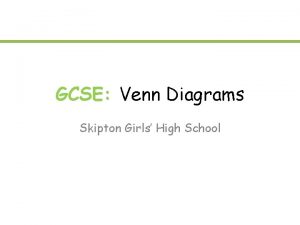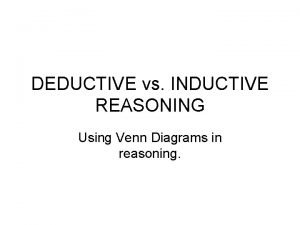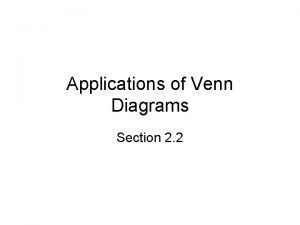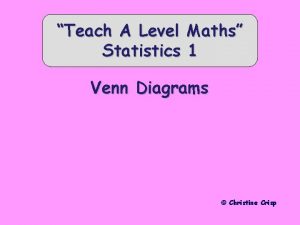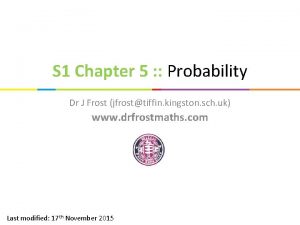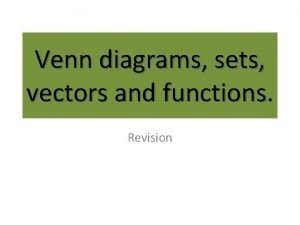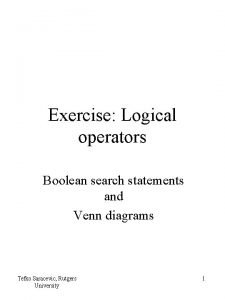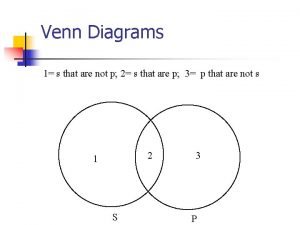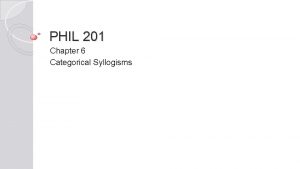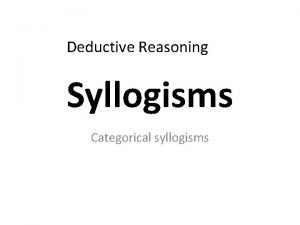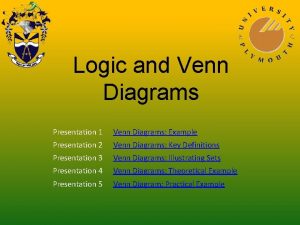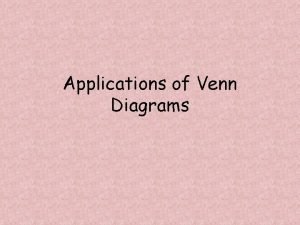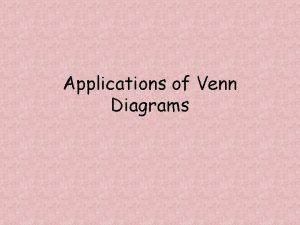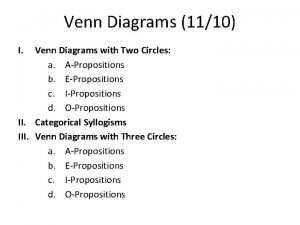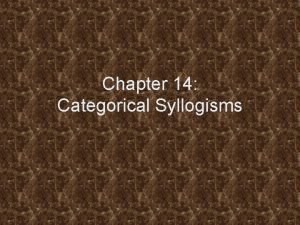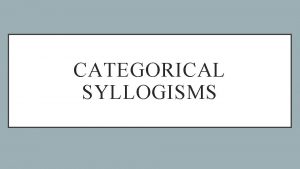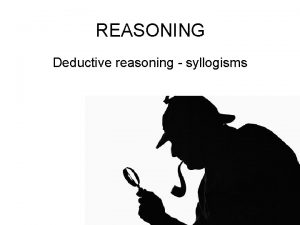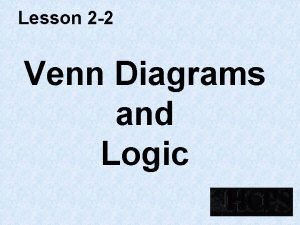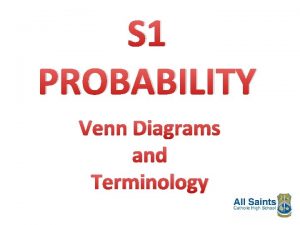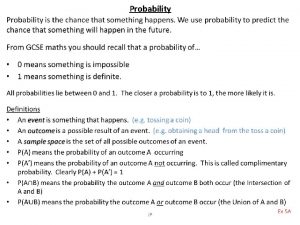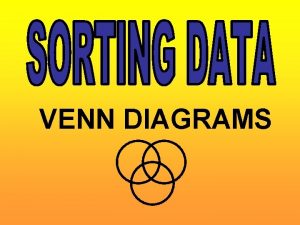Venn Diagrams and Categorical Syllogisms Unit 5 John






























- Slides: 30

Venn Diagrams and Categorical Syllogisms Unit 5

John Venn • 1834 – 1923 • English logician and philosopher noted for introducing the Venn diagram • Used in set theory, probability, logic, statistics, and computer science

Classes of things represented in circles:

Shading means the class or set of items is empty – there are none that fit that description:

Comparing two different classes:

All are, “every” vs. No are, “none”, “nothing”

Representing subjects and predicates visually:

All S are P. Universal Categorical Statement All members of the subject class are also members of the predicate class. All sharks are predators. (The circle on the left represents sharks, the circle on the left is predators. ) All apples are sweet. We’ve shaded out the area where the non-predator sharks would have been, and where the non-sweet apples would have been. This is known as an “A” statement.

No S are P. Universal Categorical Statement No members of the subject class are also members of the predicate class. No salmon are porpoises. We shaded the area where a “salmon-porpoise” would have been, because there cannot be anything existing in that area. This is known as an “E” statement.

Some S are P. Particular Categorical Statement Some members of the subject class are also members of the predicate class. Some sailors are privates. The X is placed where the sailors who are also privates would exist. This is known as the “I” statement.

Some S are not P. Particular Categorical Statement Some members of the subject class are not members of the predicate class. Some scholars are not philosophers. This is known as the “O” form statement.

A, E, I, O • There are four basic categorical statement types, named A, E, I, and O. • The quantity of a categorical proposition is either universal, or particular. • The quality of a categorical proposition is either affirmative, or negative.

A, E, I, O and their quantity and quality • A is the universal affirmative statement. • E is the universal negative statement. • I is the particular affirmative statement. • O is the particular negative statement.

The meaning of “some” • In categorical logic “some” means “at least one”, which is considered its minimal meaning. • “Some” is the standard form particular quantifier. • So, for example, the I statement, “Some buses used by the city are roadworthy machines”, would mean there’s at least one bus used by the city (but not necessarily any more than that one) that is a roadworthy machine.

The Square of Opposition: How the four types of categorical statements relate to each other

Practice: Which diagram goes with each of the following categorical propositions? Give the letter type, and draw the Venn diagram. • 1. No Catholics are Protestants. • 2. Some cats are Persians. • 3. Some dogs are not hunters. • 4. All Georgians are Americans. • 5. No fish are bipeds.

Categorical Syllogisms • Made up of three statements, giving three specific classes of things and how they relate • http: //philosophy. hku. hk/think/venn/tute 3. ph p • The webpage above is interactive, and shows how the three statements can be placed on a Venn Diagram made of three circles.

Imagine how to shade in: • All men are mortal. • Socrates is a man. • Therefore, Socrates is mortal.

First shade in All men are mortal:

Socrates is a Man And check to see if there is a space where Socrates can be mortal as well – there is, where the X appears below: This is considered “valid” because the Venn diagram shows that the conclusion is necessarily true: there is no space left for a Socrates who is nonmortal!

Checking what is true on a Venn diagram:

Checking what is true on a Venn diagram:

Venn Diagram checker • http: //philosophy. hku. hk/think/vennprogram. php • Use this link to double check how you represent statements on Venn diagrams • The page immediately after it explains how to use “ticks” on a Venn diagram to check Categorical Syllogism arguments for validity

Mood (cont. ) • • Example: All dictators are tyrants. All czars are dictators. Therefore, all czars are tyrants. • The mood of this example is AAA.

A Question For You • Selecting from the list below, what is the mood of this syllogism? • No candidates are witnesses. • Some lawyers are witnesses. • So, some lawyers are not candidates. • • A. B. C. D. OIE IOE EIO AOI

Answer • Selecting from the list below, what is the mood of this syllogism? • No candidates are witnesses. • Some lawyers are witnesses. • So, some lawyers are not candidates. • • A. B. C. D. OIE IOE EIO (Correct) AOI

Figure • The figure of a syllogism is determined by the position of the middle term. • Example: • All dictators are tyrants. • All czars are dictators. • Therefore, all czars are tyrants. • In this example the middle term is “dictators”.

Substituting the letters for the terms (M) dictators- (P) tyrants (S) czars- (M) dictators (S) czars- (P) tyrants This gives us: MP SM SP S refers to the subject term of the conclusion. P refers to the predicate term of the conclusion. M is the middle term, it only appears in the premises.

The 4 Figures: MP SM SP 1 STfigure PM SM SP 2 NDfigure MP MS SP 3 rd figure PM MS SP 4 th figure

Figures represented as a bow tie and collar on the M (middle terms) Figure: 1 2 3 4
 What is a statistical syllogism?
What is a statistical syllogism? Major premise in syllogism
Major premise in syllogism Example of syllogism
Example of syllogism Vennogram
Vennogram Categorical syllogism venn diagram examples
Categorical syllogism venn diagram examples The interaction diagrams, use case diagrams are called as
The interaction diagrams, use case diagrams are called as Uml activity diagram tutorial
Uml activity diagram tutorial Shade a-b in a venn diagram
Shade a-b in a venn diagram Lesson 4.3 two way tables and venn diagrams
Lesson 4.3 two way tables and venn diagrams Venn diagram vocabulary
Venn diagram vocabulary How to find lcm and hcf using venn diagram
How to find lcm and hcf using venn diagram Venn diagrams and two way tables
Venn diagrams and two way tables Gcse venn diagram
Gcse venn diagram Mathspad venn diagrams
Mathspad venn diagrams Probability of a given b formula
Probability of a given b formula Mutually exclusive probability venn diagram
Mutually exclusive probability venn diagram Introduction of venn diagram
Introduction of venn diagram Venn diagrams gcse
Venn diagrams gcse Example of deductive argument
Example of deductive argument Applications of venn diagrams
Applications of venn diagrams Venn diagram a level
Venn diagram a level Tree diagrams dr frost
Tree diagrams dr frost Scalar and vector venn diagram
Scalar and vector venn diagram Deductive reasoning venn diagrams
Deductive reasoning venn diagrams Boolean venn diagrams
Boolean venn diagrams Conditional probability with venn diagrams
Conditional probability with venn diagrams Venn diagram example tagalog
Venn diagram example tagalog John adams vs thomas jefferson venn diagram
John adams vs thomas jefferson venn diagram Andrew carnegie and john d. rockefeller venn diagram
Andrew carnegie and john d. rockefeller venn diagram Unit 10, unit 10 review tests, unit 10 general test
Unit 10, unit 10 review tests, unit 10 general test Kant hypothetical imperative
Kant hypothetical imperative

